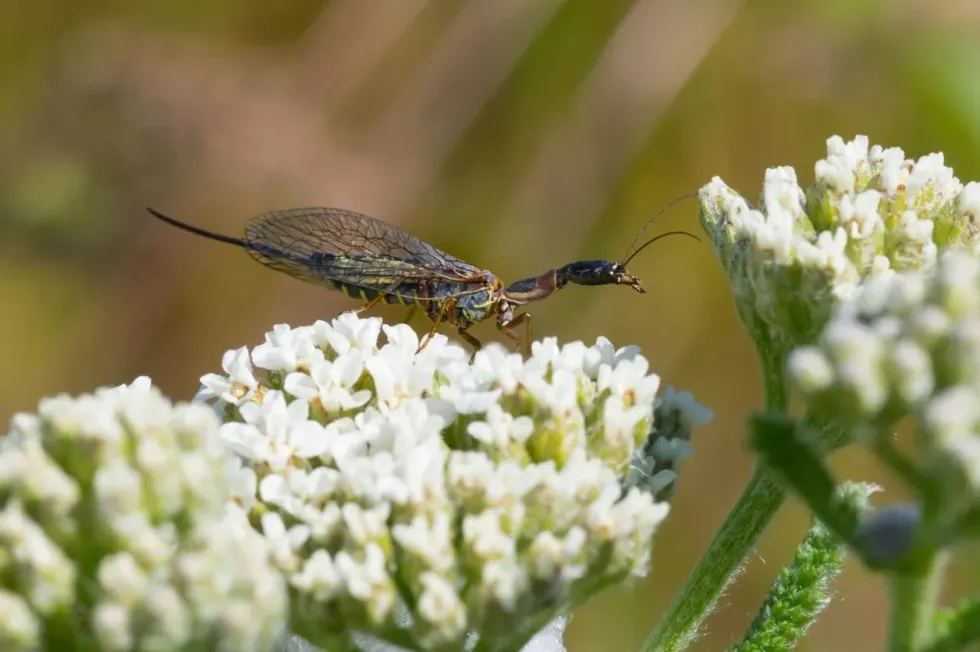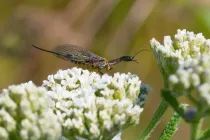In the insect world, there are many different kinds of insects, and a lot of them are classified on the basis of what they eat. While a range of insects rely on pollen and fruits, other kinds prey on smaller insects. One such predator insect is the snakefly.
They are from the order raphidioptera and are very common in North America. These snakeflies are closely related to dragonflies. They are also very closely related to Neuroptera and Megaloptera families as well.
The raphidioptera family has two different extensions which are raphidiidae and inocelliidae. The other name for this family is raphidiodea. They are present almost everywhere but there are some areas where groups of insects cannot sustain themselves.
The lifespan of an adult snakefly is very interesting. Groups of insects such as snakeflies are known as holometabolous, meaning their lifespan consists of four major stages.
The cycle begins from the egg, then larvae, the larvae then live and become pupae, and then comes the adult snakefly. The snakefly larvae have large elongated heads and they are unlike any other larvae which you might come across. Their life cycle is distributed in four stages and the larva stage is very crucial.
To learn more about insects that you might find in your garden or during your picnic, make sure to check out our mud dauber wasp facts and mayfly fact pages.
Snakefly Interesting Facts
What type of animal is a snakefly?
Adult snakeflies are an insect from the raphidiodea family which can be also be known as raphidiidae. These snakeflies are predators by nature and they are from the raphidioptera order.
What class of animal does a snakefly belong to?
Snakeflies, which people most commonly spot sitting on tree bark, are from the order raphidioptera and class Insecta. Their larvae live on the bark of the tree in the early stages, after which they merge into what we call adults.
How many snakeflies are there in the world?
It is very interesting that these snakeflies, which are closely related to neuropteran and have antennae, prothorax, have been living on earth for a long time. They have had a history that is around 140 million years old.
This snakefly from order raphidioptera has more than 260 species worldwide and they have been recorded to be living from the early Jurassic period.
Thus it can be said that snake flies are living on earth even before humans started their civilization. Despite this information, the correct measure of their population is not available.
Where does a snakefly live?
This species is distributed widely and they are present on almost every continent. Although their range is wide, members of the raphidioptera clan prefer to live in temperate coniferous forests.
A large part of their species is from Asia and Europe and also North America. They are also found in the central parts of America. This small-headed snakefly is also present in Africa and even in some places with higher altitudes.
What is a snakefly's habitat?
It's very important for adult snakeflies to find a place where their snakefly larvae can live and flourish. Hence they often don't go above altitudes higher than 10,000 ft (3000 m). The raphidioptera clan is often restricted to a single mountain group. They like dense forests as their larvae live on tree bark.
Who do snakeflies live with?
The female and male often stay together during the time when they laying eggs, but mostly they seem to live alone and feed on aphids. This genus does not live in a group but their neighbors, species who have the same habitat conditions as them, can include the common wasp and the cuckoo wasp.
How long does a snakefly live?
The life cycle of the snakefly is divided into four parts. The first starts with them being eggs, the eggs are often oviposited at certain positions, preferably tree bark.
The eggs then turn to larva. The larvae have a very big and elongated head, projecting mandibles. The rest of the body of the larva is soft, they generally have three legs at this stage and no wings.
The next stage is pupa and then they change from the soft larva into a fully functioning snakefly. Their life cycle lasts for six years.
How do they reproduce?
Adult snake flies reproduce in a very interesting way. Male adults first clean themselves before the mating session, during which time they groom their antenna and legs.
The male generally lies in a tandem position with respect to the female and the copulation lasts for several hours, after which begins the lifecycle of a new snakefly. First, the larvae and their big head come into the picture, after which the pupa stage comes, lasting for a good two to three years.
For some clans other than raphidiodea, the pupa stage can even last for six years.
The pupa doesn't have any wings however they can bite when it comes to food time or when they are disturbed. The larvae begin to become adults during late summer or sometimes during early august.
What is their conservation status?
The conservation status of this insect with wings is Not Extinct.
Snakefly Fun Facts
What do snakeflies look like?
It's very easy to identify adult male and female snakeflies as they have long prothorax, although they don't have forelegs. The head is long and it also looks flattened from the front view.
They have one pair of wings, and their wings often show colored pterostigma. They can be seen in gardens but generally live in the north or central part of America.
Some people believe that they don't have any neck while some think that part of their previously mentioned elongated head is actually their long neck.
They have large eyes on both sides of their head and their wings are very large. Small eggs of this genu can be seen hanging on tree bark crevices, however as they are very small, one needs to look closely.
The prothorax is the major sign when identifying a raphidiodea. They don't have any stinger, just a really long antenna and legs.

How cute are they?
Some people find these small flying insects very cute and they indeed look very wonderful when flying with their two large wings. They are familiar to humans and often roam around in a range of gardens or picnic spots.
How do they communicate?
Acoustics is the known means of communication among snakeflies.
How big is a snakefly?
Snakeflies are almost equal in size to all their related species, but they are almost five times the size of a solitary bee and twice the size of a yellow jacket wasp.
How fast can a snakefly fly?
Each wing is very special and very large and these wings help them fly better and faster.
How much does a snakefly weigh?
Snakflies have a million year old history on earth and although we have known of this species for quite some time now, it's very difficult to examine their weight, as they are very small and almost feather like in weight.
What are the male and female names of the species?
Both the male and the female are called by the same names, they have the same kind of long neck and both of them have wings after becoming adults.
What would you call a baby snakefly?
Baby insects are called nymphs and snakeflies' babies are called nymphs as well.
What do they eat?
They generally prey on small insects such as aphids and caterpillars.
Are they poisonous?
No, they are not poisonous. Some people mistake their long antenna for a stinger but they are completely harmless to humans, although they eat a range of small insects.
Would they make a good pet?
It's unlikely that they are good pets. Although no comments have been made on this subject, snakeflies are the kind of species that are at their best when in nature and flying from one garden to another, eating aphids. They simply cannot be made pets.
Did you know...
The meaning of the name raphidioptera is 'the needle' in greek. They were named needle because of their elongated antenna.
They are also known to be walking skeletons because of their exoskeleton.
Does the snakefly have a neck?
Yes, they have a long neck and two big eyes across their head.
Does the snakefly have a tongue?
No, they don't have a tongue, they instead have proboscis to suck up food or nectar or blood.
Here at Kidadl, we have carefully created lots of interesting family-friendly animal facts for everyone to discover! Learn more about some other arthropods from our botfly facts and damselfly facts pages.
You can even occupy yourself at home by coloring in one of our free printable snakefly coloring pages.
Second image by Richard Bartz.









